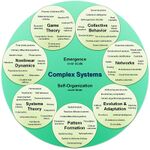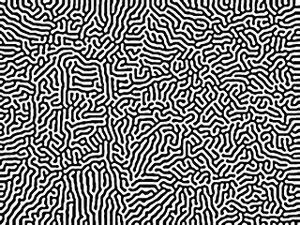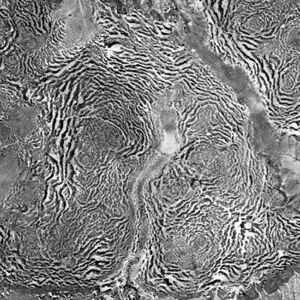斑图生成
本词条由11初步翻译,由CecileLi初步审校 https://wiki.swarma.org/index.php?title=%E5%B9%B3%E8%A1%A1%E7%90%86%E8%AE%BA#:~:text=%E6%9C%AC%E8%AF%8D%E6%9D%A1%E7%94%B1,11%E5%88%9D%E6%AD%A5%E7%BF%BB%E8%AF%91
 |
| Complex systems |
|---|
| Topics |
Pattern formation in a computational model of dendrite growth.
图例:在枝晶生长的计算模型中形成的模式
The science of pattern formation deals with the visible, (statistically) orderly outcomes of self-organization and the common principles behind similar patterns in nature.
The science of pattern formation deals with the visible, (statistically) orderly outcomes of self-organization and the common principles behind similar patterns in nature.
斑图生成学涉及的是自发性组织中可见的,通常也是可统计的有序的结果,以及自然界中相似模式背后的共同原理。
In developmental biology, pattern formation refers to the generation of complex organizations of cell fates in space and time. Pattern formation is controlled by genes. The role of genes in pattern formation is an aspect of morphogenesis, the creation of diverse anatomies from similar genes, now being explored in the science of evolutionary developmental biology or evo-devo. The mechanisms involved are well seen in the anterior-posterior patterning of embryos from the model organism Drosophila melanogaster (a fruit fly), one of the first organisms to have its morphogenesis studied and in the eyespots of butterflies, whose development is a variant of the standard (fruit fly) mechanism.
In developmental biology, pattern formation refers to the generation of complex organizations of cell fates in space and time. Pattern formation is controlled by genes. The role of genes in pattern formation is an aspect of morphogenesis, the creation of diverse anatomies from similar genes, now being explored in the science of evolutionary developmental biology or evo-devo. The mechanisms involved are well seen in the anterior-posterior patterning of embryos from the model organism Drosophila melanogaster (a fruit fly), one of the first organisms to have its morphogenesis studied and in the eyespots of butterflies, whose development is a variant of the standard (fruit fly) mechanism.
在 发育生物学developmental biology,中,斑图生成指的是细胞的复杂组织在时间和空间上的命运般的产生。斑图生成是由基因控制的。形态发生是由相似的基因创造出不同的解剖结构,基因在斑图生成中的作用仅是是其中的一个方面,目前演化发育生物学仍在研究这个问题。模式生物黑腹果蝇的胚胎前后图案和蝴蝶的眼点清楚地体现了这一机制,而后者的发育是果蝇的标准机制的一种变体。
Examples
Examples 实例
Examples of pattern formation can be found in biology, chemistry, physics, and mathematics,[1] and can readily be simulated with computer graphics, as described in turn below.
Examples of pattern formation can be found in biology, chemistry, physics, and mathematics, and can readily be simulated with computer graphics, as described in turn below.
在生物、化学、物理和数学中都有斑图生成的实例,并且我们可以用 计算机图形学computer graphics轻松地来模拟,下面依次进行介绍。
Biology
Biology
生物学
Biological patterns such as animal markings, the segmentation of animals, and phyllotaxis are formed in different ways.[2]
Biological patterns such as animal markings, the segmentation of animals, and phyllotaxis are formed in different ways.
动物标记、动物分节、叶序等生物学模式是以不同的方式形成的。
In developmental biology, pattern formation describes the mechanism by which initially equivalent cells in a developing tissue in an embryo assume complex forms and functions.[3] Embryogenesis, such as of the fruit fly Drosophila, involves coordinated control of cell fates.[4][5][6] Pattern formation is genetically controlled, and often involves each cell in a field sensing and responding to its position along a morphogen gradient, followed by short distance cell-to-cell communication through cell signaling pathways to refine the initial pattern. In this context, a field of cells is the group of cells whose fates are affected by responding to the same set positional information cues. This conceptual model was first described as the French flag model in the 1960s.[7][8] More generally, the morphology of organisms is patterned by the mechanisms of evolutionary developmental biology, such as changing the timing and positioning of specific developmental events in the embryo.[9]
In developmental biology, pattern formation describes the mechanism by which initially equivalent cells in a developing tissue in an embryo assume complex forms and functions. Embryogenesis, such as of the fruit fly Drosophila, involves coordinated control of cell fates. Pattern formation is genetically controlled, and often involves each cell in a field sensing and responding to its position along a morphogen gradient, followed by short distance cell-to-cell communication through cell signaling pathways to refine the initial pattern. In this context, a field of cells is the group of cells whose fates are affected by responding to the same set positional information cues. This conceptual model was first described as the French flag model in the 1960s. More generally, the morphology of organisms is patterned by the mechanisms of evolutionary developmental biology, such as changing the timing and positioning of specific developmental events in the embryo.
在发育生物学中,斑图生成描述了胚胎发育组织中最初的等效细胞呈现出复杂形态和功能的机制。 胚胎发生Embryogenesis,例如果蝇的胚胎发生,涉及到细胞命运的协调控制。模式的形成是遗传控制的,通常涉及一个场中的每个细胞沿着形态原梯度感知和响应其位置,然后通过细胞信号通路进行短距离的细胞间通信,以完善初始模式。在此背景下,细胞场 a field of cells是指通过响应同一组位置信息线索而影响其命运的一组细胞。这个概念模型最早在20世纪60年代被描述为法旗模型。更一般地说,生物体的形态是由进化发育生物学的机制所决定的,如改变胚胎中特定发育事件的时间和位置。
Possible mechanisms of pattern formation in biological systems include the classical reaction–diffusion model proposed by Alan Turing[10] and the more recently found elastic instability mechanism which is thought to be responsible for the fold patterns on the cerebral cortex of higher animals, among other things.[11][12]
Possible mechanisms of pattern formation in biological systems include the classical reaction–diffusion model proposed by Alan Turing and the more recently found elastic instability mechanism which is thought to be responsible for the fold patterns on the cerebral cortex of higher animals, among other things.
生物系统中可能的斑图生成机制制包括阿兰 · 图灵Alan Turing提出的经典反应扩散模型和最近发现的弹性不稳定机制,该机制被认为是高等动物大脑皮层上褶皱模式的原因,等等。
Growth of colonies
Growth of colonies
菌落生长
Bacterial colonies show a large variety of patterns formed during colony growth. The resulting shapes depend on the growth conditions. In particular, stresses (hardness of the culture medium, lack of nutrients, etc.) enhance the complexity of the resulting patterns.[13] Other organisms such as slime moulds display remarkable patterns caused by the dynamics of chemical signaling.[14]
Bacterial colonies show a large variety of patterns formed during colony growth. The resulting shapes depend on the growth conditions. In particular, stresses (hardness of the culture medium, lack of nutrients, etc.) enhance the complexity of the resulting patterns. Other organisms such as slime moulds display remarkable patterns caused by the dynamics of chemical signaling.
细菌菌落在菌落生长过程中形成的形态种类繁多。所形成的形状取决于生长条件。特别是,压力(培养基的硬度、营养物质的缺乏等)增强了所产生的模式的复杂性。其他生物,如粘液霉菌,则显示出由化学信号动态引起的显著模式。
Vegetation patterns
Vegetation patterns
植被模式
Tiger bush is a vegetation pattern that forms in arid conditions.
[虎灌木是在干旱条件下形成的植被模式。]
Vegetation patterns such as tiger bush[15] and fir waves[16] form for different reasons. Tiger bush consists of stripes of bushes on arid slopes in countries such as Niger where plant growth is limited by rainfall. Each roughly horizontal stripe of vegetation absorbs rainwater from the bare zone immediately above it.[15] In contrast, fir waves occur in forests on mountain slopes after wind disturbance, during regeneration. When trees fall, the trees that they had sheltered become exposed and are in turn more likely to be damaged, so gaps tend to expand downwind. Meanwhile, on the windward side, young trees grow, protected by the wind shadow of the remaining tall trees[16]. In flat terrains additional pattern morphologies appear besides stripes - hexagonal gap patterns and hexagonal spot patterns. Pattern formation in this case is driven by positive feedback loops between local vegetation growth and water transport towards the growth location[17][18].
Vegetation patterns such as tiger bush and fir waves form for different reasons. Tiger bush consists of stripes of bushes on arid slopes in countries such as Niger where plant growth is limited by rainfall. Each roughly horizontal stripe of vegetation absorbs rainwater from the bare zone immediately above it..
虎灌木和冷杉波等植被模式形成的原因不同。在尼日尔等干旱国家,植物生长受到降雨的限制,虎灌木由干旱斜坡上的带状灌木组成。每一条大致水平的植被带都可以从紧靠其上方的裸露地带吸收雨水。
Chemistry
Chemistry
化学
模板:FurtherPattern formation has been well studied in chemistry and chemical engineering, including both temperature and concentration patterns.[19] The Brusselator model developed by Ilya Prigogine and collaborators is one such example that exhibits Turing instability.[20] Pattern formation in chemical systems often involve oscillatory chemical kinetics or autocatalytic reactions[21] such as Belousov–Zhabotinsky reaction or Briggs–Rauscher reaction. In industrial applications such as chemical reactors, pattern formation can lead to temperature hot spots which can reduce the yield or create hazardous safety problems such as a thermal runaway.[22][19] The emergence of pattern formation can be studied by mathematical modeling and simulation of the underlying reaction-diffusion system.[19][21]
Pattern formation has been well studied in chemistry and chemical engineering, including both temperature and concentration patterns. The Brusselator model developed by Ilya Prigogine and collaborators is one such example that exhibits Turing instability. Pattern formation in chemical systems often involve oscillatory chemical kinetics or autocatalytic reactions such as Belousov–Zhabotinsky reaction or Briggs–Rauscher reaction. In industrial applications such as chemical reactors, pattern formation can lead to temperature hot spots which can reduce the yield or create hazardous safety problems such as a thermal runaway. The emergence of pattern formation can be studied by mathematical modeling and simulation of the underlying reaction-diffusion system.
斑图生成已经在化学和化学工程中得到了很好研究,包括温度和浓度模式。由伊利亚·普里戈吉因Ilya Prigogine和其合作者开发的Brusselator模型就是这样一个表现出图灵不稳定性的例子。化学体系中的模式形成通常涉及 振荡化学动力学oscillatory chemical kinetics或 自催化反应autocatalytic reactions,如Belousov-Zhabotinsky反应或Briggs-Rauscher反应。在工业应用中,如化学反应堆,模式形成可能导致温度热点,这可能降低产量或造成危险的安全问题,如热失控。模式形成的出现可以用潜在的反应扩散系统的数学建模与模拟来研究。
Physics
Physics
物理学
In the 1980s Lugiato and Lefever developed a model of light propagation in an optical cavity that results in pattern formation by the exploitation of nonlinear effects.
In the 1980s Lugiato and Lefever developed a model of light propagation in an optical cavity that results in pattern formation by the exploitation of nonlinear effects.
20世纪80年代,卢贾托Lugiato和勒弗Lefever开发了一个光在光学腔中传播的模型,该模型通过利用非线性效应形成图案。
Bénard cells, laser, cloud formations in stripes or rolls. Ripples in icicles. Washboard patterns on dirtroads. Dendrites in solidification, liquid crystals. Solitons.
Bénard cells, laser, cloud formations in stripes or rolls. Ripples in icicles. Washboard patterns on dirtroads. Dendrites in solidification, liquid crystals. Solitons.
贝纳尔细胞,激光,云层形成的条状或卷状。冰柱上的涟漪 泥路上的洗衣板图案。凝固中的树枝状,液晶。孤子
Mathematics
Mathematics
数学
Sphere packings and coverings. Mathematics underlies the other pattern formation mechanisms listed.
Sphere packings and coverings. Mathematics underlies the other pattern formation mechanisms listed.
球形填料和覆盖物。数学是其他斑图生成机制的基础。
Computer graphics
Computer graphics
计算机图形学

Pattern resembling a reaction–diffusion model, produced using sharpen and blur
类似反应-扩散模型,使用锐化和模糊技术制作的图案。
Some types of automata have been used to generate organic-looking textures for more realistic shading of 3d objects.[23][24]
Some types of automata have been used to generate organic-looking textures for more realistic shading of 3d objects.
一些类型的自动机已经被用来生成看起来有机的纹理,以便对三维物体进行更真实的阴影处理。
A popular Photoshop plugin, KPT 6, included a filter called 'KPT reaction'. Reaction produced reaction–diffusion style patterns based on the supplied seed image.
A popular Photoshop plugin, KPT 6, included a filter called 'KPT reaction'. Reaction produced reaction–diffusion style patterns based on the supplied seed image.
一个流行的Photoshop插件,KPT6,包括一个名为“KPT反应”的过滤器。反应根据提供的种子图像产生反应-扩散风格的图案。
A similar effect to the 'KPT reaction' can be achieved with convolution functions in digital image processing, with a little patience, by repeatedly sharpening and blurring an image in a graphics editor. If other filters are used, such as emboss or edge detection, different types of effects can be achieved.
A similar effect to the 'KPT reaction' can be achieved with convolution functions in digital image processing, with a little patience, by repeatedly sharpening and blurring an image in a graphics editor. If other filters are used, such as emboss or edge detection, different types of effects can be achieved.
利用数字图像处理中的 卷积函数convolution functions,只要稍有耐心,在图形编辑器中反复对图像进行锐化和模糊处理,就能达到类似 "KPT反应 "的效果。如果使用其他滤镜,如浮雕或边缘检测,可以实现不同类型的效果。
Computers are often used to simulate the biological, physical or chemical processes that lead to pattern formation, and they can display the results in a realistic way. Calculations using models like reaction–diffusion or MClone are based on the actual mathematical equations designed by the scientists to model the studied phenomena.
Computers are often used to simulate the biological, physical or chemical processes that lead to pattern formation, and they can display the results in a realistic way. Calculations using models like reaction–diffusion or MClone are based on the actual mathematical equations designed by the scientists to model the studied phenomena.
计算机经常被用来模拟导致斑图生成的生物、物理或化学过程,并能以真实的方式显示结果。使用反应-扩散或MClone等模型进行计算,是根据科学家设计的实际数学方程来模拟所研究的现象。
References
References
参考资料
- ↑ Ball, 2009.
- ↑ Ball, 2009. Shapes, pp. 231–252.
- ↑ Ball, 2009. Shapes, pp. 261–290.
- ↑ Eric C. Lai (March 2004). "Notch signaling: control of cell communication and cell fate". Development. 131 (5): 965–73. doi:10.1242/dev.01074. PMID 14973298.
- ↑ Melinda J. Tyler, David A. Cameron (2007). "Cellular pattern formation during retinal regeneration: A role for homotypic control of cell fate acquisition". Vision Research. 47 (4): 501–511. doi:10.1016/j.visres.2006.08.025. PMID 17034830.
{{cite journal}}: CS1 maint: uses authors parameter (link) - ↑ Hans Meinhard (2001-10-26). "Biological pattern formation: How cell[s] talk with each other to achieve reproducible pattern formation". Max-Planck-Institut für Entwicklungsbiologie, Tübingen, Germany.
- ↑ Wolpert L (October 1969). "Positional information and the spatial pattern of cellular differentiation". J. Theor. Biol. 25 (1): 1–47. doi:10.1016/S0022-5193(69)80016-0. PMID 4390734.
- ↑ Wolpert, Lewis (2007). Principles of development (3rd ed.). Oxford [Oxfordshire]: Oxford University Press. ISBN 978-0-19-927536-6.
- ↑ Hall, B. K. (2003). "Evo-Devo: evolutionary developmental mechanisms". International Journal of Developmental Biology. 47 (7–8): 491–495. PMID 14756324.
- ↑ S. Kondo, T. Miura, "Reaction-Diffusion Model as a Framework for Understanding Biological Pattern Formation", Science 24 Sep 2010: Vol. 329, Issue 5999, pp. 1616-1620 DOI: 10.1126/science.1179047
- ↑ Mercker, M; Brinkmann, F; Marciniak-Czochra, A; Richter, T (4 May 2016). "Beyond Turing: mechanochemical pattern formation in biological tissues". Biology Direct. 11: 22. doi:10.1186/s13062-016-0124-7. PMC 4857296. PMID 27145826.
- ↑ Tallinen et al. Nature Physics 12, 588–593 (2016) doi:10.1038/nphys3632
- ↑ Ball, 2009. Branches, pp. 52–59.
- ↑ Ball, 2009. Shapes, pp. 149–151.
- ↑ 15.0 15.1 Tongway, D.J., Valentin, C. & Seghieri, J. (2001). Banded vegetation patterning in arid and semiarid environments. New York: Springer-Verlag. ISBN 978-1461265597.
- ↑ 16.0 16.1 D'Avanzo, C. (22 February 2004). "Fir Waves: Regeneration in New England Conifer Forests". TIEE. Retrieved 26 May 2012.
- ↑ Meron, E (2019). "Vegetation pattern formation: the mechanisms behind the forms". Physics Today. 72 (11): 30–36. doi:10.1063/PT.3.4340.
- ↑ Meron, E (2018). "From Patterns to Function in Living Systems: Dryland Ecosystems as a Case Study". Annual Review of Condensed Matter Physics. 9: 79–103. doi:10.1146/annurev-conmatphys-033117-053959.
- ↑ 19.0 19.1 19.2 Gupta, Ankur; Chakraborty, Saikat (January 2009). "Linear stability analysis of high- and low-dimensional models for describing mixing-limited pattern formation in homogeneous autocatalytic reactors". Chemical Engineering Journal. 145 (3): 399–411. doi:10.1016/j.cej.2008.08.025. ISSN 1385-8947.
- ↑ Prigogine, I.; Nicolis, G. (1985), Hazewinkel, M.; Jurkovich, R.; Paelinck, J. H. P. (eds.), "Self-Organisation in Nonequilibrium Systems: Towards A Dynamics of Complexity", Bifurcation Analysis: Principles, Applications and Synthesis, Springer Netherlands, pp. 3–12, doi:10.1007/978-94-009-6239-2_1, ISBN 9789400962392
- ↑ 21.0 21.1 Gupta, Ankur; Chakraborty, Saikat (2008-01-19). "Dynamic Simulation of Mixing-Limited Pattern Formation in Homogeneous Autocatalytic Reactions". Chemical Product and Process Modeling. 3 (2). doi:10.2202/1934-2659.1135. ISSN 1934-2659.
- ↑ Marwaha, Bharat; Sundarram, Sandhya; Luss, Dan (September 2004). "Dynamics of Transversal Hot Zones in Shallow Packed-Bed Reactors†". The Journal of Physical Chemistry B. 108 (38): 14470–14476. doi:10.1021/jp049803p. ISSN 1520-6106.
- ↑ Greg Turk, Reaction–Diffusion
- ↑ Andrew Witkin; Michael Kassy (1991). "Reaction–Diffusion Textures" (PDF). Proceedings of the 18th Annual Conference on Computer Graphics and Interactive Techniques: 299–308. doi:10.1145/122718.122750. ISBN 0897914368.
Bibliography
Bibliography
参考书目
- Ball, Philip (2009). Nature's Patterns: a tapestry in three parts. 1:Shapes. 2:Flow. 3:Branches. Oxford. ISBN 978-0199604869.
External links
External links
外部链接
- SpiralZoom.com, an educational website about the science of pattern formation, spirals in nature, and spirals in the mythic imagination.
- '15-line Matlab code', A simple 15-line Matlab program to simulate 2D pattern formation for reaction-diffusion model.
Category:Developmental biology
类别: 发育生物学
Category:Articles containing video clips
类别: 包含视频剪辑的文章
Category:Pattern formation
类别: 模式形成
This page was moved from wikipedia:en:Pattern formation. Its edit history can be viewed at 斑图生成/edithistory
